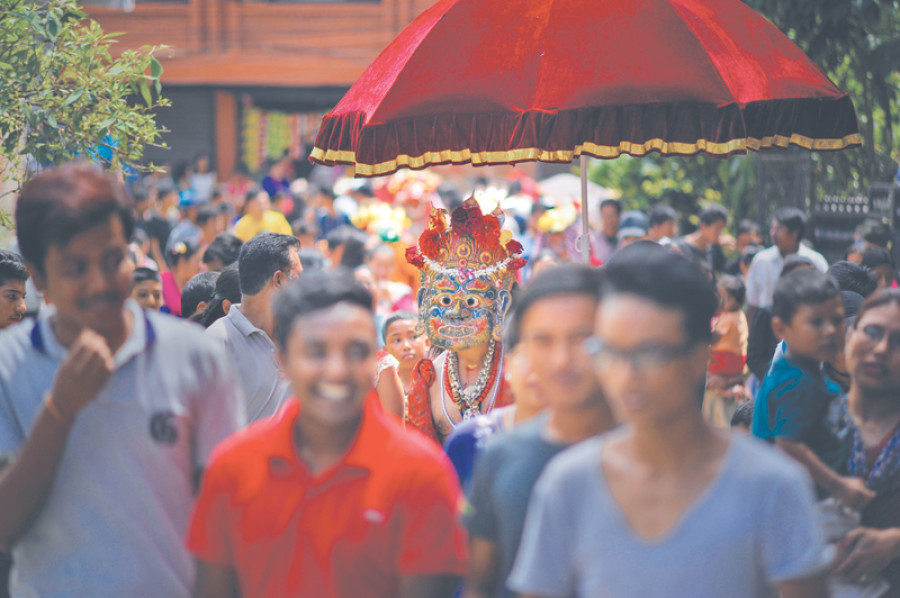Miscellaneous
A God for the day
Once a year, the day after the Capital reverberates with Gai Jatra’s laughter and merriment, Sitaram leads the age-old Payo Jatra—a tradition locals claim to have been initiated during the Lichhavi era.
Sanjit Pradhananga
Text: Sanjit Pradhananga
Photos: Rabindra Prajapati
Sitaram Prajapati says that once he dons the Bhairab mask and grabs on to the payo, his consciousness goes into a time warp. He then leads a procession of ajimas around the ancient Capital of Handigaun at the will of an indescribable rush that courses through his entire being. “Once I wear the khwapa, I become just a medium. I don’t know how to explain it to someone who has never felt it for themselves. I feel immense, all powerful and fearless—like nothing in the world could stop me.”
 The synchronised procession requires Sitaram to lead with both his arms raised in a defiant stance.
The synchronised procession requires Sitaram to lead with both his arms raised in a defiant stance.
Once a year, the day after the Capital reverberates with Gai Jatra’s laughter and merriment, Sitaram leads the age-old Payo Jatra—a tradition locals claim to have been initiated during the Lichhavi era. According to Sitaram, Kwati Punih (Janai Purnima) kicks off a string of festivities for the Newars and, the procession, with the wrathful Bhairab at the fore, is reminder to spirits and negative energies to steer clear of the settlement. “I feel Bhairab’s presence the strongest when we are at a crossroad. They say that’s where negative energies are the most concentrated.”
 Sitaram is led by an entourage towards Handigaun's central intersection.
Sitaram is led by an entourage towards Handigaun's central intersection.
The day of the Payo Jatra—or Khadga Jatra after Sankirtisation—begins early for the Prajapati household. Sitaram gets up at the crack of dawn and gets his nails clipped and hair trimmed while his family readies paraphernalia for the long, intricate ceremonies that are to follow. Preparations are led by Sitaram’s father, 76-year-old Shiva Prajapati, who himself donned the Bhairab mask for 45 years, before handing down the duties to his son three years ago because of a bad knee.
 Bhairab leads a long line of ajimas during the jatra. The ajimas join the procession voluntarily from various households in the settlement.
Bhairab leads a long line of ajimas during the jatra. The ajimas join the procession voluntarily from various households in the settlement.
“The preparation has to be very meticulous. Of all the Gods, Bhairab is not the one you want to anger,” he says, only half-joking.
Unlike the Majipa Lakhey—Kathmandu’s most popular masked dance—Sitaram is not intoxicated before he assumes the role of a godhead for the day. In fact, it is essential that he remains on an empty stomach for the duration of the entire Jatra.
 Sitaram gets his nails clipped at the crack of dawn.
Sitaram gets his nails clipped at the crack of dawn.
“You transcend to another plane, food is the last thing on my mind.”
His mind is solely focused on making sure the Jatra takes place like it has done for millenniums and the Prajapati family, who have been custodians of the Bhairav mask and the payo for generations, take immense pride in their obligations. The next day, Sitaram reintegrates back into Handigaun’s still extremely tight-knit community and returns to driving vehicles for a living.
But not today.
Today, even as his physical body is dancing to the rhythms of the dhime, his mind is elsewhere.
Today, an energy that has no origins is coursing through his veins.
Today, Sitaram is Bhairab
incarnate.
 (Left) Shiva Prajapati readies the Khadga for the Jatra. (Right) The mask, now severely faded in places, is polished with egg whites to give it sheen.
(Left) Shiva Prajapati readies the Khadga for the Jatra. (Right) The mask, now severely faded in places, is polished with egg whites to give it sheen.
 (Left) Family members help Sitaram put on his attire for the day. (Right) The would-be godhead makes his way to a Chowk for a puja before the jatra.
(Left) Family members help Sitaram put on his attire for the day. (Right) The would-be godhead makes his way to a Chowk for a puja before the jatra.

'When I put on the mask, I feel immense, all powerful-like nothing could stop me.'




 7.12°C Kathmandu
7.12°C Kathmandu










